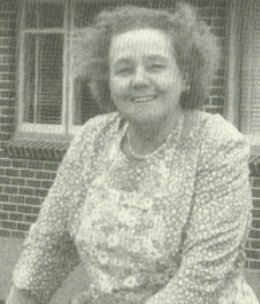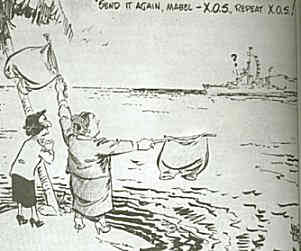![]()
Coasts
Rivers/Lakes
Lowlands/Plains
Geysers/Mud
Glaciers
Mt. Ruapehu
Mt. Cook
White Island
A Maori Legend
![]()
Abbotsford
Aramoana
Ballantynes
Brynderwyns
Cave Creek
Hawkes Bay
H.M.S. Orpheus
Influenza
Mt. Erebus
Mt. Tarawera
Rainbow Warrior
Seacliff Hospital
Tangiwai
Wahine
![]()
Annie Aves
Ata-hoe
Daisy Basham
Jean Batten
Minnie Dean
Mabel Howard
Margaret Mahy
Kath Mansfield
Kate Sheppard
Kiri Te Kanawa
Catherine Tizard
Murray Ball
Charles Goldie
Edmund Hillary
Richard Pearse
Lord Rutherford
Charles Upham
![]()
NZ FAQ--Funny
NZ Links
Credits
"I believe in the equality of the sexes. I truly believe that men are just as equal as women in the work they do. I believe that a man should have equal chances with a woman."-Mabel Howard. When I was doing this section I debated with myself as to which politicians I should include. A popular (actually, very UNpopular) suggestion was New Zealand's first female Prime Minister, Jenny Shipley. Sorry Jenny, you lost out to Mabel Howard who won because she was anything but dull. Mabel Howard came to New Zealand in 1903 with her father and sisters. In 1908 she took a course at Christchurch Technical College, during which time she learnt shorthand, a talent she would later use in parliament to record things said by other members. At the same time she joined the Socialist Party, the forerunner of todays Labour Party. With a father who was active in the trade union movement, before himself entering parliament, it was not surprising that these areas also attracted Mabel. In 1934 she became secretary of the Canterbury General Labourers Union; it was here that her reputation for being direct and 'giving as good as she got' began. She chased one worker reluctant to pay his subscription fees up three stories of scaffolding, and another over piled up wool bales; they paid their dues and she earned their respect. Using such methods she raised membership numbers from 300 to over 7,000. In 1942 she was the first woman appointed national secretary of the New Zealand Federated Labourers Union. At this point in her career Mabel said that she wished to be treated like a male as she thought men had the best chances in life. Her father died in 1939 and Mabel was passed over for his parliamentary seat. She then contested Christchurch East during a by-election in 1943; the only woman amongst nine nominees she was selected as Labour candidate and took the seat with a majority of 1,000 votes. In 1946 she became the member for Sydenham and in 1947, after twelve ballots, this lead to her appointment as the first woman Cabinet minister, handling health and child welfare. When Labour returned to power in 1957 Mabel was still holding the Sydenham seat and was made minister of social security and minister in charge of the welfare of women and children. Health has always been a challenging portfolio and that was no different for Mabel Howard. During her time as health minister tuberculosis was running rife in New Zealand with 40-50 new cases reported each week and 2-3 people dying from the disease each day. This was a worse threat to the country than AIDS is today with an average of 2,385 cases being reported each year since 1943. TB had a particular significance for Mabel Howard as her mother died of it. The Bill she introduced in 1948 gave the needed legal support to do the following things:
Though the Bill was supported by the Opposition it still took a year to take effect; by that time new surgical and drug treatments had become available and were saving many people from the ravages of the disease. Chest hospitals remained until the 1970s, children were routinely vaccinated against the illness and X-ray machines used to discover new cases. At the time X-ray were very costly but early detection meant a much better chance of successful treatment.
1948 saw a polio outbreak and Mabel exercised her right to close all schools; this she did for six weeks. But after that time the number of cases being reported had not reduced so she offered Prime Minister Peter Fraser her resignation, this he rejected. Passionate about the underprivileged, animals and women's rights, Mabel was considered a character. She is perhaps best remembered for her 'bloomer demonstration'. The quality and standards of clothing was of immense concern to Mabel; one day she held up a new dress, worn and washed once, which had shrunk so considerably she could no longer fit into it. Her opinion was that all goods should carry the standards mark so the public could have confidence in what they bought. Being the only female member of the House she stated she was unable to talk about certain things because they were rather intimate. Nevertheless, she offered to do so saying, "If the honourable members can stand it, I can." Now she spoke of ladies bloomers and the method of manufacture which involved stretching the fabric, a practice which resulted in extreme shrinkage during the first wash. She pushed for the mark of the Standards Institute to be applied to more items; this provided manufacturers with specifications for their products to meet but the only products legally required to carry the mark were home appliances. Later a shoe was displayed along with the standards mark and she stated the need to educate the public as to its meaning. In 1944, ten years after she first raised issues of standardising clothing the event for which she is best remembered occurred. The House was debating a Bill requiring goods to be marked with the country of their origin. Mabel criticised the fact that no women's organisations had been asked their opinion on this Bill, only men's groups. Her clothing issues then came to the fore once again when she stated that all measurements should be given in inches so people knew the real size of an item -- including those of underclothes. This caused a ripple of laughter among the MP's. Howard promptly told them they hadn't seen anything yet and pointed out how important this was to low income households. Women could not be expected to shop with a tape measure and underclothes were not able to be tried on in the store so shoppers had to trust much to luck. Stating she regretted the lack of models, she prominently raised two pairs of ladies bloomers for parliamentary viewing. Though they were obviously different in size both were marked as OS (outsized). Though the action was considered positively outrageous it had the desired effect with male members recording difficulty in buying shirts or underwear themselves, the reason being inaccurate sizing. It was agreed the Bill did contain a clause which would address Mabel Howard's concerns and discussion began with manufacturers over garment standardisation. Her immense love of animals led to her fight to enact the Prevention of Cruelty to Animals Bill in 1960. She collected stray cats and owned up to seven at a time, being reluctant to take trips or holidays away and sparing no expense in their care and feeding. Mabel was president of the Canterbury SPCA for nearly twenty years and often visited strays in her local cattery. Mabel retired in 1969 after two years of experiencing increasing illness, including several bouts of pneumonia and increasing memory loss. During the preceding two years she barely spoke a word in the House. Reluctant to retire, a new party ruling that members must leave at 70 forced her to go, something she felt was aimed particularly at her. She then withdrew from friends and was living alone without any hobbies or interests. After some months of debate with her family a magistrate's order was obtained and Mabel Howard committed to Sunnyside psychiatric hospital where she spent her final two years before dying in her sleep from pneumonia.
|



